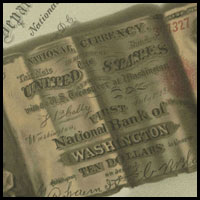

Designed to replace the corrupt, decentralized, and inefficient system of state banks and bank notes, the National Bank Act of 1863 was largely the work of Secretary of the Treasury Salmon P. Chase and Senate Finance Committee member John Sherman of Ohio. The act had three objectives: to create a market for war bonds, to reestablish the central banking system destroyed during President Andrew Jackson’s administration, and to develop a stable bank-note currency. As amended in 1864, the Bank Act established the Office of Comptroller of the Currency, and permitted banks to obtain federal charters and issue national bank notes up to 90 percent of their holdings of United States bonds. “This system of national banks has furnished to the people of the United States a currency combining the national faith with the private stock and private credit of individuals,” Senator Sherman later wrote in his memoir. “They have a currency that is safe, uniform, and convertible.” With modifications, this system remained the backbone of the nation's monetary structure until creation of the Federal Reserve System in 1913.
Information provided by the Senate Historical Office.